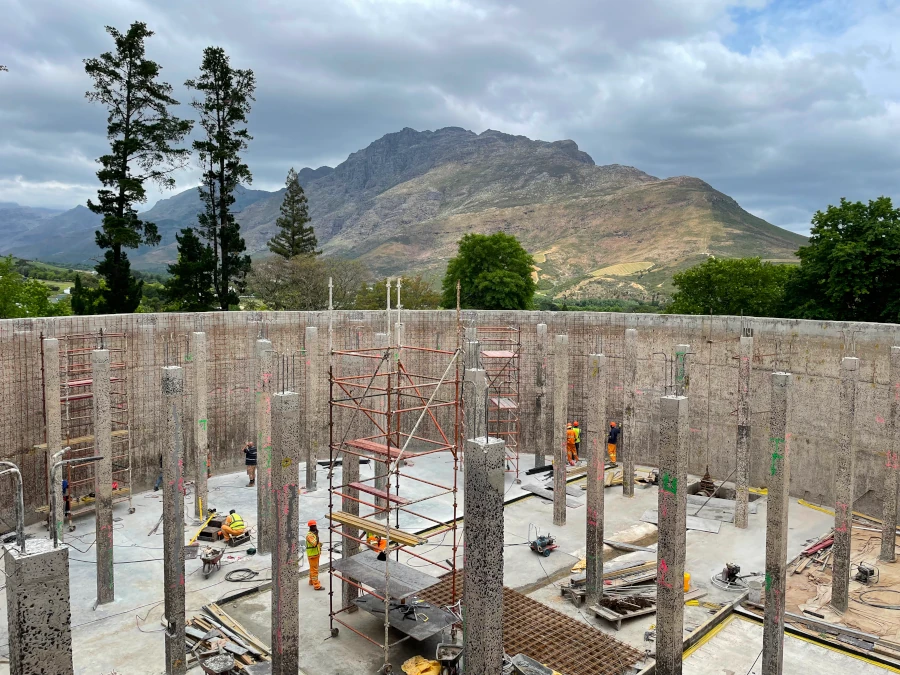- +27 (0) 10 109 2987
- info@penetron.africa
Project Context:
Upgrading Stellenbosch’s Rozendal Reservoir Without Demolition
The Rozendal Reservoir, situated in Stellenbosch, South Africa, plays a vital role in municipal water storage for the surrounding community. Due to the age and deterioration of the structure, Stellenbosch Municipality commissioned a strategic upgrade to ensure long-term functionality and durability. Rather than opting for a full demolition and rebuild, the project team adopted an innovative, environmentally conscious rehabilitation approach. Lafarge supplied the ready-mix concrete.
The engineering solution involved constructing a new structural lining inside the existing reservoir shell, allowing the team to restore functionality while drastically reducing environmental impact.
The Challenge:
A Sustainable Solution to Restore Ageing Infrastructure Without Demolition
The existing reservoir structure had reached the end of its design life and was showing clear signs of deterioration. However, the municipality was determined to avoid the high carbon cost of demolition. The new solution would need to ensure long-term durability, eliminate the need for external waterproofing membranes, and protect against aggressive exposure conditions, particularly alkali-silica reaction (ASR) and chloride ingress. Additionally, the project had to be completed without disrupting the community’s water supply.
These requirements called for a system that could integrate seamlessly with new concrete work, offer reliable waterproofing, resist chemical attack, and contribute meaningfully to reducing the structure’s environmental footprint.


Photo Credit: AECOM, Terry February Photography
The Solution
Penetron’s crystalline waterproofing and repair system
The project specification centred around Penetron’s crystalline waterproofing and repair system, selected for its ability to deliver permanent waterproofing, self-healing capabilities, and long-term resistance to aggressive environmental exposure. Two core products were used:
Penetron Admix
Incorporated directly into all new concrete used in the reservoir lining, including the 150 mm in-situ floor slab, the 120 mm shotcrete wall layer, and the 120 mm roof screed. Once added during batching, the Penetron Admix reacts with water and unhydrated cement particles to form insoluble crystals within the concrete matrix. These crystals block pores and microcracks, creating a permanent internal barrier to water and chemical ingress.
The benefits of Penetron Admix included integrated self-healing capability that seals microcracks over time, protection against alkali-silica reaction (ASR) and chloride penetration, and the elimination of external membranes – reducing labour, time, and cost.
Penetron Slurry and Penecrete Mortar
To treat exposed soffits and beam surfaces, Penetron Slurry was applied as a brush-on crystalline coating. This topical treatment further reduced permeability and provided surface-level protection, particularly in areas where formwork was not replaced.
Where cracks larger than 0.5 mm or surface damage existed in the original concrete, Penecrete Mortar was used in conjunction with Penetron Slurry to seal and reinforce those areas. The mortar chemically bonds with both the substrate and the slurry, ensuring a continuous crystalline barrier throughout the structure.
Together, these products formed a fully integrated waterproofing and durability system, delivering long-term structural integrity and significantly reducing the need for future maintenance.
The Implementation
Sustainable Construction with Minimal Disruption and Maximum Efficiency
A key advantage of this project was the ability to use the existing reservoir as permanent formwork for the new internal lining. This drastically reduced the need for demolition, waste disposal, and new material usage. Concrete was cast in-situ and shotcreted directly onto prepared surfaces, significantly improving installation efficiency.
The use of Penetron technology allowed for waterproofing and crack protection to be addressed as an integral part of the concrete itself, avoiding the delays and complexity associated with external waterproofing systems. The construction process remained clean and well-controlled, with minimal disruption to surrounding infrastructure and no interruption to the water supply.



Photo Credit: AECOM, Terry February Photography
The Results
Long-Term Durability and Sustainability Achieved at Rozendal Reservoir
The Rozendal project delivered measurable success in performance, sustainability, and cost-effectiveness:
- Waterproofed Concrete Surfaces – without membranes
- Extended Service Life – improved durability under harsh conditions
- Crack Resistance – through crystalline self-healing action
- Reduced Carbon Footprint – less demolition, steel, and concrete
- Lower Material & Labour Costs – through simplified installation
The reservoir now provides long-term water security for the community, with minimal maintenance requirements.
Conclusion
Rozendal Reservoir Proves the Power of Penetron's Crystalline Technology
The Rozendal Reservoir project highlights the effectiveness of Penetron’s crystalline waterproofing system in the rehabilitation of aging infrastructure. Through the integration of self-healing admixtures and high-performance repair mortars, the team delivered a result that was structurally sound, cost-effective, environmentally responsible, and aligned with long-term municipal service goals.
This case study serves as a strong example of how modern materials and engineering foresight can revitalise critical infrastructure, without the need for a complete rebuild.
Contact Penetron Africa
Planning to rehabilitate infrastructure while reducing costs and carbon emissions?
Contact Penetron Africa to learn how our crystalline waterproofing solutions can protect and extend the life of your next concrete project.



